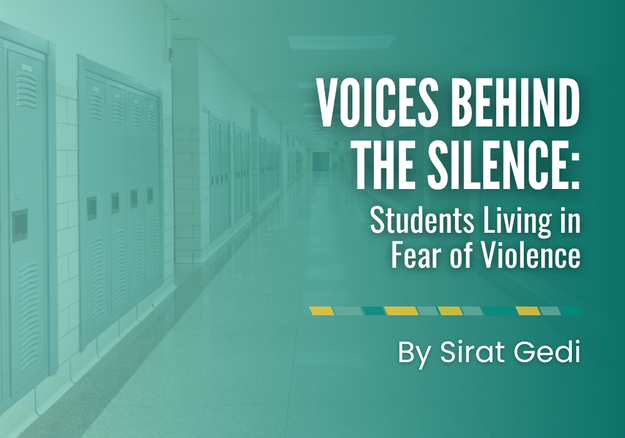Voices Behind the Silence: Students Living in Fear of Violence
Sirat Gedi | November 14, 2025
I never expected to experience violence so close to home, especially living in such a small neighbourhood in Ontario. Growing up, I witnessed how violence within and around schools can alter the way students see education, safety, and even themselves. I remember walking through the halls after yet another lockdown, hearing whispers about fights, stabbings, and police outside the building. Fear started to feel routine and silence became the easiest way to cope.
Everything changed the year a student was shot and killed just steps away from our school. The news spread fast; not through official channels, but through texts, panic, and tears. The grief that followed wasn’t confined to classrooms; it seeped into every hallway, every conversation, every quiet glance between friends. Suddenly, “Are you okay?” became a question that carried new weight.
Our community had been shaken by loss, and yet, the system’s response felt distant. While officials debated policy and policing, students were left to navigate grief and anxiety with little support. We were told to “move on,” but how do you move on when safety no longer feels like a guarantee?
⸻
That tragedy was not an isolated event, it was a reflection of a larger crisis. Across Ontario, violence in schools has become alarmingly common. According to the Elementary Teachers’ Federation of Ontario (2024), 77 percent of educators say they have personally experienced or witnessed violence in schools, and among those working in special education, the rate rises to 86 percent. The 2023–24 school year saw over 4,400 violent incidents reported across Ontario. This was a 77 percent increase since 2018–19. Within the Toronto District School Board, 323 students were involved in violent incidents during one academic year; the highest in half a decade.
These numbers paint a grim picture of a system under strain. Teachers are burned out, students are scared, and parents are losing trust in the very institutions meant to keep their children safe. But statistics only tell part of the story, behind every incident are young people trying to learn while coping with trauma that no teenager should carry.
⸻
When the shooting happened, our school became a place defined by unease. Security measures were tightened, police presence increased, and yet, the tension never truly left. The deeper issue; the grief, fear, and lack of emotional support, was left unspoken.
For many students, that silence was louder than the violence itself. It’s in the way teachers hesitated before bringing up the event in class, in the way some parents pulled their kids out of after-school programs, in the way certain hallways stayed quieter than before. We learned to adapt to danger instead of addressing it.
This is the reality for too many young people across Ontario. Violence doesn’t begin with one incident — it builds slowly through poverty, systemic inequities, and the normalization of fear. When schools are underfunded and mental health supports are scarce, students internalize the message that their safety is secondary to their performance.
“Violence in schools doesn’t start with bad kids — it starts with broken systems.”
It’s easy to call for stricter discipline or more police in schools, but those are reactive measures. They don’t heal trauma or restore trust. What students need are environments that prioritize connection, mental health, and understanding. When young people have someone to talk to, violence is less likely to be their only form of expression.
Yet, across Ontario, schools are struggling to provide even the basics. Guidance counsellors are stretched thin, social workers are shared across multiple schools, and mental health services are often waitlisted. According to the Ontario Secondary School Teachers’ Federation (2024), three out of four education workers report an increase in violent incidents since they began their careers, and one in three say they’ve been physically assaulted at work.
If adults inside the system feel unsafe, how can students be expected to feel protected?
“It’s time we stop asking youth to adapt to unsafe schools
and start asking schools to adapt to youth.”
A violence-free tomorrow requires more than reaction. It requires reflection and reform. That means:
- Expanding mental health services in schools, with counsellors and youth workers trained in trauma-informed and culturally responsive care.
- Implementing restorative justice programs that promote accountability, empathy, and healing instead of exclusion.
- Increasing funding for schools in high-needs areas to hire more support staff and reduce class sizes.
- Listening to students through youth-led safety councils that inform school and board-level policies.
- Publicly reporting data on school violence; disaggregated by region, race, and gender, to ensure transparency and targeted interventions.
Violence is not inevitable; it’s preventable. But only if we treat it as a public health issue rooted in community conditions, not just classroom behaviour.
⸻
I can’t forget the day of the shooting — or the weeks that followed. The fear lingers, but so does the determination to ensure that no student has to learn under the shadow of violence again. A violence-free tomorrow isn’t just about safer hallways; it’s about rebuilding trust, nurturing empathy, and creating spaces where every student can thrive.
Because no young person should have to learn what it feels like to fear their own school.
 Sirat Gedi OCIC Youth Policy-Makers Hub Member
Sirat Gedi OCIC Youth Policy-Makers Hub Member
Sirat is an undergraduate student at the University of Toronto Scarborough, pursuing a major in Health Studies – Population Health. With lived experience navigating the intersections of race, faith, gender, and migration, she is passionate about advancing equity and fostering inclusive, community-driven solutions to global challenges. Her academic and advocacy work centers on health equity, gender justice, and reducing systemic inequalities.







